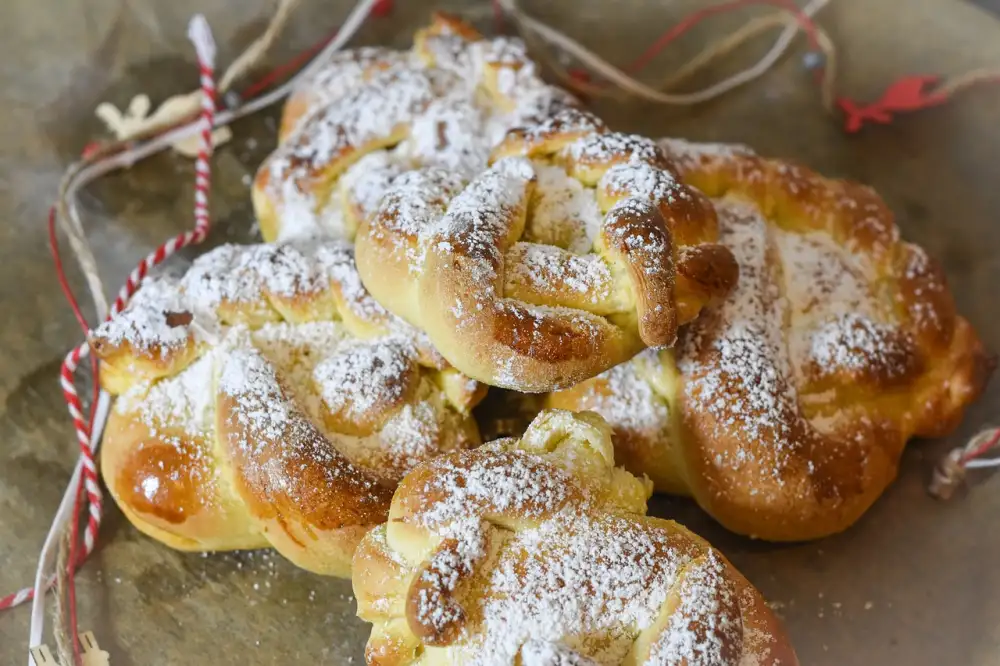Brioche Bliss: Indulge in the Irresistible French Bread Delight

- History of Brioche: From Royal Origins to Culinary Icon
- Ingredients of Brioche: Unveiling the Secrets of its Richness
- Brioche Variations: Discovering the Different Flavors and Shapes
- Baking Brioche: Step-by-Step Guide to Creating the Perfect Loaf
- Serving Suggestions: Pairing Brioche with Sweet and Savory Delights
- Brioche in Popular Culture: Its Influence in Art, Literature, and Film
- Health Benefits of Brioche: Debunking Myths and Embracing Moderation
Brioche, the beloved French bread delight, is a true indulgence for the senses. With its golden crust and buttery, tender crumb, brioche has captivated food lovers around the world. This rich and decadent bread is known for its irresistible taste and delicate texture. Whether enjoyed on its own or used as a base for sandwiches or desserts, brioche never fails to impress with its unique flavor profile. Join us on a journey through the world of brioche, where we explore its history, ingredients, variations, and more. Get ready to experience the bliss of this French bread delight!
History of Brioche: From Royal Origins to Culinary Icon
Brioche, the beloved French bread, has a rich history that dates back to the 16th century. It is believed to have originated in the region of Normandy and was initially enjoyed by royalty and the upper class. Brioche gained popularity during the reign of Louis XIV, who had a particular fondness for its buttery and fluffy texture. Over time, brioche became a symbol of indulgence and luxury, making its way into the culinary world as a true icon of French cuisine. Today, it continues to captivate taste buds around the globe with its irresistible charm and timeless appeal.
Ingredients of Brioche: Unveiling the Secrets of its Richness
The richness of brioche lies in its exquisite combination of ingredients. Flour, eggs, butter, sugar, and yeast are the key components that give this French bread its distinctive taste and texture. The high proportion of butter gives brioche its tender crumb and delicate flavor. The addition of eggs adds richness and a beautiful golden hue to the bread. Sugar provides a touch of sweetness, while yeast helps the dough rise and creates its light and airy structure. These carefully selected ingredients work together harmoniously to create a bread that is truly indulgent and irresistible.
Brioche Variations: Discovering the Different Flavors and Shapes
Brioche, with its rich and buttery flavor, is a versatile bread that comes in various flavors and shapes. One popular variation is the "brioche à tête," which has a distinctive round shape with a small dough ball on top. This shape allows for even baking and creates an appealing presentation. Another variation is the "brioche Nanterre," which is baked in a rectangular loaf pan, making it perfect for slicing and toasting. Other flavors include chocolate brioche, where cocoa powder or chocolate chips are added to the dough, and fruit-filled brioche, which can be filled with anything from jam to fresh berries. With so many variations to choose from, there's a brioche for every taste preference.
Baking Brioche: Step-by-Step Guide to Creating the Perfect Loaf
1. Start by combining warm milk, sugar, and yeast in a bowl. Let it sit for about 5 minutes until the yeast activates and becomes frothy.
2. In a separate large mixing bowl, whisk together flour and salt. Create a well in the center and add in the yeast mixture along with beaten eggs.
3. Using a wooden spoon or electric mixer with dough hooks, mix the ingredients until they come together to form a sticky dough.
4. Gradually add softened butter, one tablespoon at a time, while continuing to mix the dough. This will take some time but be patient as it is crucial for achieving that rich brioche texture.
5. Once all the butter is incorporated, continue kneading the dough for about 10 minutes until it becomes smooth and elastic.
6. Transfer the dough to a greased bowl, cover it with plastic wrap or a clean kitchen towel, and let it rise in a warm place for about 1-2 hours or until doubled in size.
7. After the first rise, gently punch down the dough to release any air bubbles that may have formed. Divide it into equal portions depending on your desired brioche shape – whether it's rolls, loaves, or braids.
8. Shape each portion of dough into desired shapes and place them onto baking sheets lined with parchment paper.
9. Cover them loosely with plastic wrap or kitchen towels and let them rise again for another hour until they double in size once more.
10. Preheat your oven to 375°F (190°C). Before baking, you can brush the tops of your brioche with an egg wash for a shiny golden crust if desired.
11. Bake your brioche in the preheated oven for approximately 20-25 minutes or until they turn golden brown on top and sound hollow when tapped.
12. Once baked, remove the brioche from the oven and let them cool on wire racks before serving. Enjoy your homemade brioche with a cup of coffee or use it as a base for delightful sandwiches or French toast.
Serving Suggestions: Pairing Brioche with Sweet and Savory Delights
Brioche's versatility extends beyond its delightful taste and texture. It serves as a perfect accompaniment to both sweet and savory dishes, making it a versatile addition to any meal.
For a sweet treat, spread some Nutella or jam on a toasted slice of brioche for a heavenly breakfast or snack. The buttery richness of the bread pairs perfectly with the sweetness of these spreads. Alternatively, use brioche to make French toast, soaking it in a mixture of eggs, milk, and cinnamon before frying it to golden perfection.
When it comes to savory delights, brioche can elevate any sandwich or burger experience. Its softness and slight sweetness provide an excellent contrast to savory fillings like grilled chicken or beef patties. Add some lettuce, tomato, and your favorite condiments for a mouthwatering combination.
For a more elegant affair, serve brioche alongside foie gras or smoked salmon for an indulgent appetizer. The delicate flavors of these ingredients complement the buttery notes of the bread beautifully.
No matter how you choose to enjoy it, brioche's ability to enhance both sweet and savory flavors makes it an irresistible choice for any mealtime delight.
Brioche in Popular Culture: Its Influence in Art, Literature, and Film
Brioche, with its rich and buttery flavor, has not only captured the hearts of food enthusiasts but has also made its way into popular culture. This delectable French bread delight has been featured in various art forms, literature, and even film. In paintings, brioche often symbolizes indulgence and luxury, showcasing its status as a culinary icon. In literature, it is often used to depict decadence and opulence, adding depth to the characters' experiences. And in films, brioche is showcased as a mouthwatering treat that evokes desire and pleasure. Its presence in popular culture further solidifies brioche's allure and charm.
Health Benefits of Brioche: Debunking Myths and Embracing Moderation
Brioche, with its buttery and fluffy texture, is often associated with indulgence rather than health. However, it's important to debunk the myths surrounding this delectable French bread. While it is true that brioche is high in calories and fat, it also offers some nutritional benefits. It contains essential nutrients like protein and carbohydrates, which provide energy for the body. Additionally, brioche contains vitamins and minerals such as iron and calcium. However, moderation is key when enjoying brioche. Pair it with healthier options like fresh fruits or incorporate it into a balanced meal to fully savor its charm while maintaining a healthy lifestyle.
In conclusion, brioche is a truly irresistible French bread delight that has captivated taste buds around the world. Its rich history, unique ingredients, and various flavors and shapes make it a versatile and indulgent treat. Whether enjoyed on its own or paired with sweet or savory accompaniments, brioche offers a delightful experience for food lovers. So go ahead, indulge in the charm of brioche and savor every delicious bite!
Published: 01. 12. 2023
Category: Food



